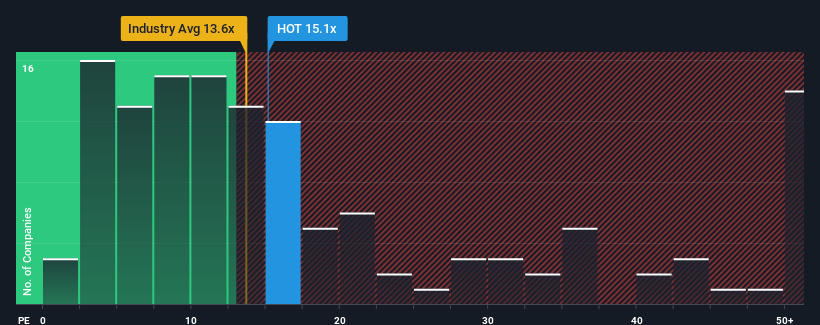- Germany
- /
- Construction
- /
- XTRA:HOT
Some Shareholders Feeling Restless Over HOCHTIEF Aktiengesellschaft's (ETR:HOT) P/E Ratio

With a median price-to-earnings (or "P/E") ratio of close to 17x in Germany, you could be forgiven for feeling indifferent about HOCHTIEF Aktiengesellschaft's (ETR:HOT) P/E ratio of 15.1x. While this might not raise any eyebrows, if the P/E ratio is not justified investors could be missing out on a potential opportunity or ignoring looming disappointment.
HOCHTIEF certainly has been doing a good job lately as it's been growing earnings more than most other companies. It might be that many expect the strong earnings performance to wane, which has kept the P/E from rising. If not, then existing shareholders have reason to be feeling optimistic about the future direction of the share price.
See our latest analysis for HOCHTIEF

What Are Growth Metrics Telling Us About The P/E?
The only time you'd be comfortable seeing a P/E like HOCHTIEF's is when the company's growth is tracking the market closely.
Taking a look back first, we see that the company grew earnings per share by an impressive 42% last year. The strong recent performance means it was also able to grow EPS by 79% in total over the last three years. Therefore, it's fair to say the earnings growth recently has been superb for the company.
Turning to the outlook, the next three years should generate growth of 2.2% each year as estimated by the eight analysts watching the company. That's shaping up to be materially lower than the 16% each year growth forecast for the broader market.
In light of this, it's curious that HOCHTIEF's P/E sits in line with the majority of other companies. Apparently many investors in the company are less bearish than analysts indicate and aren't willing to let go of their stock right now. These shareholders may be setting themselves up for future disappointment if the P/E falls to levels more in line with the growth outlook.
What We Can Learn From HOCHTIEF's P/E?
Typically, we'd caution against reading too much into price-to-earnings ratios when settling on investment decisions, though it can reveal plenty about what other market participants think about the company.
We've established that HOCHTIEF currently trades on a higher than expected P/E since its forecast growth is lower than the wider market. When we see a weak earnings outlook with slower than market growth, we suspect the share price is at risk of declining, sending the moderate P/E lower. Unless these conditions improve, it's challenging to accept these prices as being reasonable.
And what about other risks? Every company has them, and we've spotted 2 warning signs for HOCHTIEF you should know about.
Of course, you might find a fantastic investment by looking at a few good candidates. So take a peek at this free list of companies with a strong growth track record, trading on a low P/E.
Valuation is complex, but we're here to simplify it.
Discover if HOCHTIEF might be undervalued or overvalued with our detailed analysis, featuring fair value estimates, potential risks, dividends, insider trades, and its financial condition.
Access Free AnalysisHave feedback on this article? Concerned about the content? Get in touch with us directly. Alternatively, email editorial-team (at) simplywallst.com.
This article by Simply Wall St is general in nature. We provide commentary based on historical data and analyst forecasts only using an unbiased methodology and our articles are not intended to be financial advice. It does not constitute a recommendation to buy or sell any stock, and does not take account of your objectives, or your financial situation. We aim to bring you long-term focused analysis driven by fundamental data. Note that our analysis may not factor in the latest price-sensitive company announcements or qualitative material. Simply Wall St has no position in any stocks mentioned.
About XTRA:HOT
Proven track record with adequate balance sheet and pays a dividend.

